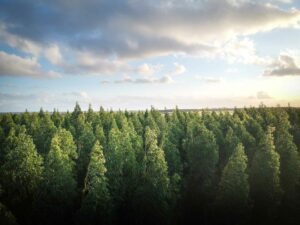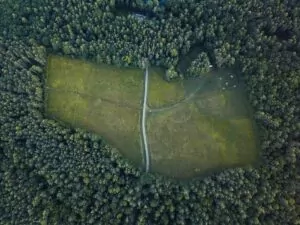 Afforestation and reforestation are terms that both refer to the act of planting trees to create a forested area. Reforestation refers to planting trees in a forest that has experienced a decrease in tree numbers or has suffered from deforestation. Meanwhile, afforestation refers to the process of growing trees in an area that previously did not have trees, creating a new forest. Both practices are beneficial to the local ecosystem alongside reducing concentrations of atmospheric carbon dioxide as forests can act as carbon sinks.
Afforestation and reforestation are terms that both refer to the act of planting trees to create a forested area. Reforestation refers to planting trees in a forest that has experienced a decrease in tree numbers or has suffered from deforestation. Meanwhile, afforestation refers to the process of growing trees in an area that previously did not have trees, creating a new forest. Both practices are beneficial to the local ecosystem alongside reducing concentrations of atmospheric carbon dioxide as forests can act as carbon sinks.
The primary motivation for afforestation is creating a new forest where there previously was no tree cover, or at least in the previous few decades (50 years according to the UNFCCC). A new, diverse ecosystem is formed, in turn increasing the number of trees over an entire area. Afforestation practices can also be targeted to reduce flooding, land degradation and erosion, or create natural windbreaks. While creating a forest has number of benefits, creating one from scratch can have many difficulties requiring careful planning.
When selecting an area to plant trees, it must be ensured that another important ecosystem is not being destroyed in the process. For example, grassland may have an ecosystem relating to a specific biome that tree planting is likely to alter. Therefore, trees have to be introduced at a slow rate to allow steady changes in the wildlife inhabiting the area. Additionally, a mixture of tree species needs to be planted, all of which must be native to the climate. This is important to avoid creating a monoculture that will attract a limited number of species.
 Reforestation is essential for restoring and replenishing existing forests. It helps to not only increase the number of trees but also increase the range of species within the forested area, thereby improving their biodiversity. Reforestation can be used in conjunction with sustainable forestry, this involves a limited number of trees within a forest being cut down, leaving significant areas of the forest untouched. Both practices have been recognised as mitigation approaches as they help to achieve carbon sequestration goals. They can also help in supporting ecosystems to adapt to climate change by reducing fragmentation and decreasing human pressure. Numerous other benefits result such as avoiding soil degradation and protecting natural resources such as water. Forests can also be a safety net for humans, for example during times of crop failure communities can utilise the projects of forests and the ecosystem they create.
Reforestation is essential for restoring and replenishing existing forests. It helps to not only increase the number of trees but also increase the range of species within the forested area, thereby improving their biodiversity. Reforestation can be used in conjunction with sustainable forestry, this involves a limited number of trees within a forest being cut down, leaving significant areas of the forest untouched. Both practices have been recognised as mitigation approaches as they help to achieve carbon sequestration goals. They can also help in supporting ecosystems to adapt to climate change by reducing fragmentation and decreasing human pressure. Numerous other benefits result such as avoiding soil degradation and protecting natural resources such as water. Forests can also be a safety net for humans, for example during times of crop failure communities can utilise the projects of forests and the ecosystem they create.
While these initiatives have their benefits, if the trees have recently been removed, it can be difficult to restore the ecosystem to what it was before, even if the trees are planted quickly. Forests are complex ecosystems that rely on a certain mixture of tree species, often including trees that are hundreds of years old. Therefore, it takes many years to recreate an old forest to its previous state and reach the earlier richness of biodiversity that inhabited the forest. Large-scale deforestation must be avoided in the first place, reforestation and afforestation are solutions once the damage has been done – prevention is better than cure.






